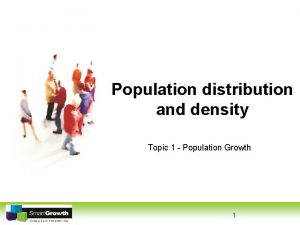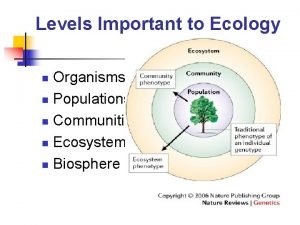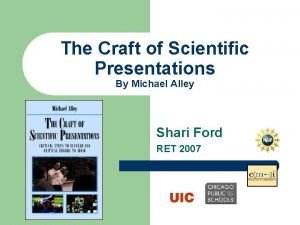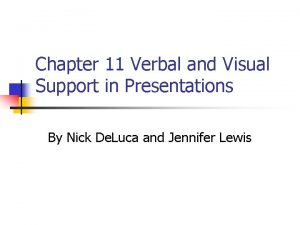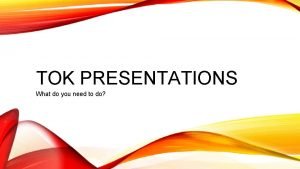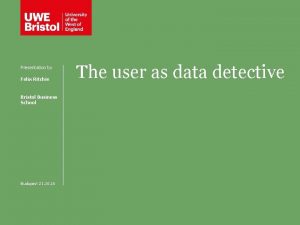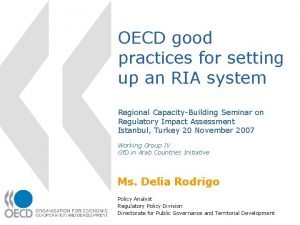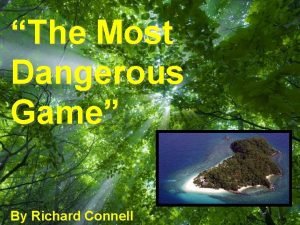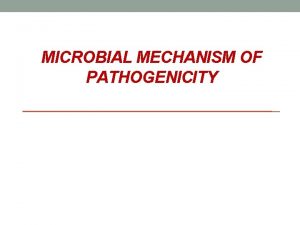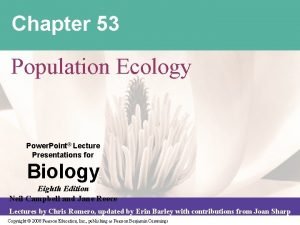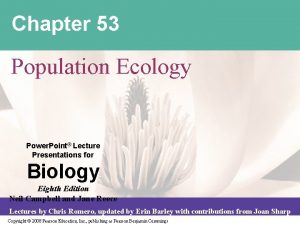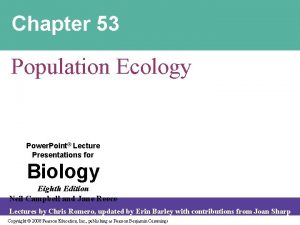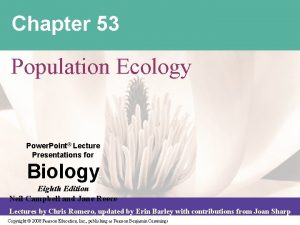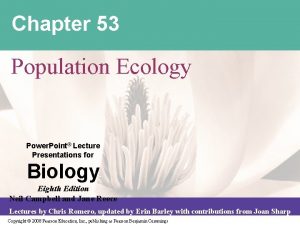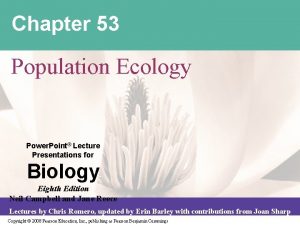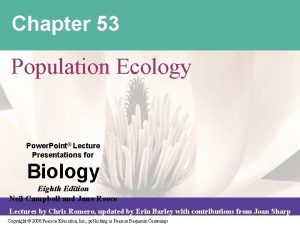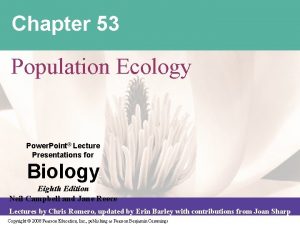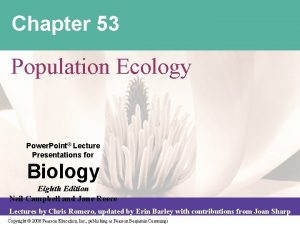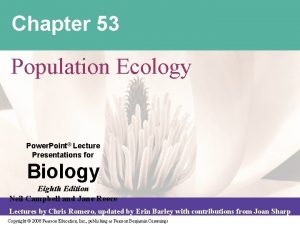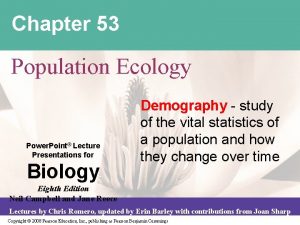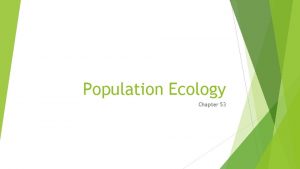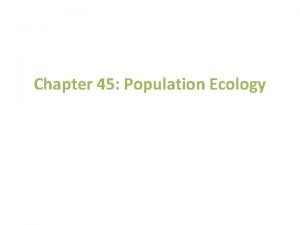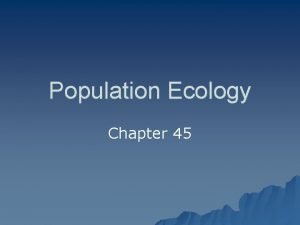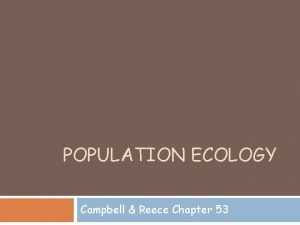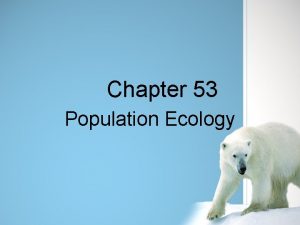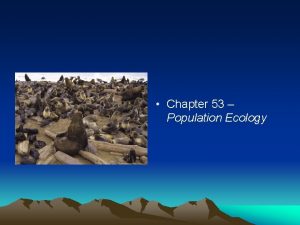Chapter 53 Population Ecology Power Point Lecture Presentations




















































- Slides: 52

Chapter 53 Population Ecology Power. Point® Lecture Presentations for Biology Eighth Edition Neil Campbell and Jane Reece Lectures by Chris Romero, updated by Erin Barley with contributions from Joan Sharp Copyright © 2008 Pearson Education, Inc. , publishing as Pearson Benjamin Cummings

Overview • Population ecology is the study of populations in relation to environment, including environmental influences on density and distribution, age structure, and population size. • A population is a group of individuals of a single species living in the same general area. Copyright © 2008 Pearson Education, Inc. , publishing as Pearson Benjamin Cummings

Dynamic biological processes influence population density, dispersion, and demographics • Density is the number of individuals per unit area or volume. • Dispersion is the pattern of spacing among individuals within the boundaries of the population. • Density is the result of an interplay between processes that add individuals to a population and those that remove individuals. Copyright © 2008 Pearson Education, Inc. , publishing as Pearson Benjamin Cummings

• Immigration is the influx of new individuals from other areas. • Emigration is the movement of individuals out of a population. • In most cases, it is impractical or impossible to count all individuals in a population. Sampling techniques can be used to estimate densities and total population sizes. • Population size can be estimated by either extrapolation from small samples, an index of population size, or the Mark-Recapture Method. Copyright © 2008 Pearson Education, Inc. , publishing as Pearson Benjamin Cummings

Population dynamics Births and immigration add individuals to a population. Immigration Deaths and emigration remove individuals from a population. Emigration

Patterns of Dispersion • Environmental and social factors influence spacing of individuals in a population. • In a clumped dispersion, individuals aggregate in patches. A clumped dispersion may be influenced by resource availability and behavior. • A uniform dispersion is one in which individuals are evenly distributed. It may be influenced by social interactions such as territoriality. • In a random dispersion, the position of each individual is independent of other individuals. It occurs in the absence of strong attractions or repulsions. Copyright © 2008 Pearson Education, Inc. , publishing as Pearson Benjamin Cummings

Patterns of dispersion within a population’s geographic range (a) Clumped (b) Uniform (c) Random

Demographics • Demography is the study of the vital statistics of a population and how they change over time. • Death rates and birth rates are of particular interest to demographers. Copyright © 2008 Pearson Education, Inc. , publishing as Pearson Benjamin Cummings

Life Tables & Survivorship Curves • A life table is an age-specific summary of the survival pattern of a population. • It is best made by following the fate of a cohort, a group of individuals of the same age. • A survivorship curve is a graphic way of representing the data in a life table. Copyright © 2008 Pearson Education, Inc. , publishing as Pearson Benjamin Cummings

Survivorship curves for squirrels shows relatively constant death rate Number of survivors (log scale) 1, 000 100 Females 10 1 Males 0 2 4 6 Age (years) 8 10

• Survivorship curves can be classified into three general types: – Type I: low death rates during early and middle life, then an increase among older age groups – Type II: the death rate is constant over the organism’s life span – Type III: high death rates for the young, then a slower death rate for survivors Copyright © 2008 Pearson Education, Inc. , publishing as Pearson Benjamin Cummings

Number of survivors (log scale) Survivorship Curves 1, 000 I 100 II 10 III 1 0 50 Percentage of maximum life span 100

Reproductive Rates • For species with sexual reproduction, demographers often concentrate on females in a population. • A reproductive table, or fertility schedule, is an age-specific summary of the reproductive rates in a population. It describes reproductive patterns of a population. Copyright © 2008 Pearson Education, Inc. , publishing as Pearson Benjamin Cummings

Life history traits are products of natural selection • An organism’s life history comprises the traits that affect its schedule of reproduction and survival: – The age at which reproduction begins – How often the organism reproduces – How many offspring are produced during each reproductive cycle • Life history traits are evolutionary outcomes reflected in the development, physiology, and behavior of an organism. Copyright © 2008 Pearson Education, Inc. , publishing as Pearson Benjamin Cummings

Evolution and Life History Diversity • Life histories are very diverse. • Species that exhibit semelparity, or big-bang reproduction, reproduce once and die. • Species that exhibit iteroparity, or repeated reproduction, produce offspring repeatedly. • Highly variable or unpredictable environments likely favor big-bang reproduction, while dependable environments may favor repeated reproduction. Copyright © 2008 Pearson Education, Inc. , publishing as Pearson Benjamin Cummings

“Trade-offs” and Life Histories • Organisms have finite resources, which may lead to trade-offs between survival and reproduction. • In animals, parental care of smaller broods may facilitate survival of offspring. • Some plants, like the dandelion, produce a large number of small seeds, ensuring that at least some of them will grow and eventually reproduce. • Other types of plants, like the coconut tree, produce a moderate number of large seeds that provide a large store of energy that will help seedlings become established. Copyright © 2008 Pearson Education, Inc. , publishing as Pearson Benjamin Cummings

Variation in the size of seed crops in plants (a) Dandelion (b) Coconut palm

The exponential model describes population growth in an idealized, unlimited environment • It is useful to study population growth in an idealized situation. • Idealized situations help us understand the capacity of species to increase and the conditions that may facilitate this growth. Copyright © 2008 Pearson Education, Inc. , publishing as Pearson Benjamin Cummings

• Zero population growth occurs when the birth rate equals the death rate. • Most ecologists use differential calculus to express population growth as growth rate at a particular instant in time: N r. N t where N = population size, t = time, and r = per capita rate of increase = birth – death Copyright © 2008 Pearson Education, Inc. , publishing as Pearson Benjamin Cummings

Exponential Growth • Exponential population growth is population increase under idealized conditions. • Under these conditions, the rate of reproduction is at its maximum, called the intrinsic rate of increase. • Exponential population growth results in a Jshaped curve • Exponential Growth is not sustainable. Copyright © 2008 Pearson Education, Inc. , publishing as Pearson Benjamin Cummings

Exponential Growth Model 2, 000 Population size (N) d. N = 1. 0 N dt 1, 500 d. N = 0. 5 N dt 1, 000 500 0 0 5 10 Number of generations 15

The J-shaped curve of exponential growth characterizes some rebounding populations Elephant population 8, 000 6, 000 4, 000 2, 000 0 1900 1920 1940 Year 1960 1980

The logistic model describes how a population grows more slowly as it nears its carrying capacity • Exponential growth cannot be sustained for long in any population. A more realistic population model limits growth by incorporating carrying capacity. • Carrying capacity (K) is the maximum population size the environment can support. • In the logistic population growth model, the rate of increase declines as carrying capacity is reached. • The logistic model of population growth produces a sigmoid (S-shaped) curve. Copyright © 2008 Pearson Education, Inc. , publishing as Pearson Benjamin Cummings

Logistic Growth model Exponential growth Population size (N) 2, 000 d. N = 1. 0 N dt 1, 500 K = 1, 500 Logistic growth 1, 000 d. N = 1. 0 N dt 1, 500 – N 1, 500 0 0 5 10 Number of generations 15

The Logistic Model and Real Populations • The growth of laboratory populations of paramecia fits an S-shaped curve. • These organisms are grown in a constant environment lacking predators and competitors. • Some populations overshoot K before settling down to a relatively stable density. Copyright © 2008 Pearson Education, Inc. , publishing as Pearson Benjamin Cummings

Number of Daphnia/50 m. L Number of Paramecium/m. L The growth of laboratory populations fits an S-shaped curve which hovers around the Carrying Capacity of the area. 1, 000 800 600 400 200 0 180 150 120 90 60 30 0 0 5 10 Time (days) 15 (a) A Paramecium population in the lab 0 20 40 60 80 100 120 Time (days) (b) A Daphnia population in the lab 140 160

The Logistic Model and Life Histories • Life history traits favored by natural selection may vary with population density and environmental conditions. • K-selection = density-dependent selection, selects for life history traits that are sensitive to population density. • r-selection = or density-independent selection, selects for life history traits that maximize reproduction. Copyright © 2008 Pearson Education, Inc. , publishing as Pearson Benjamin Cummings

Many factors that regulate population growth are density dependent • There are two general questions about regulation of population growth: – What environmental factors stop a population from growing indefinitely? – Why do some populations show radical fluctuations in size over time, while others remain stable? Copyright © 2008 Pearson Education, Inc. , publishing as Pearson Benjamin Cummings

Population Change and Population Density • In density-independent populations, birth rate and death rate do not change with population density. • In density-dependent populations, birth rates fall and death rates rise with population density. Copyright © 2008 Pearson Education, Inc. , publishing as Pearson Benjamin Cummings

Density-Dependent Population Regulation • Density-dependent birth and death rates are an example of negative feedback that regulates population growth. • They are affected by many factors, such as competition for resources, territoriality, disease, predation, toxic wastes, and intrinsic factors. • In crowded populations, increasing population density intensifies competition for resources and results in a lower birth rate. Copyright © 2008 Pearson Education, Inc. , publishing as Pearson Benjamin Cummings

Percentage of juveniles producing lambs Decreased reproduction at high population densities 100 80 60 40 200 300 400 500 Population size 600

Territoriality • In many vertebrates and some invertebrates, competition for territory may limit density. • Cheetahs are highly territorial, using chemical communication to warn other cheetahs of their boundaries. Copyright © 2008 Pearson Education, Inc. , publishing as Pearson Benjamin Cummings

Territoriality (a) Cheetah marking its territory (b) Gannets

Disease, Predation, & Toxic Wastes • Population density can influence the health and survival of organisms. In dense populations, pathogens can spread more rapidly. • As a prey population builds up, predators may feed preferentially on that species. • Accumulation of toxic wastes can contribute to densitydependent regulation of population size. • For some populations, intrinsic (physiological) factors appear to regulate population size. Copyright © 2008 Pearson Education, Inc. , publishing as Pearson Benjamin Cummings

Population Dynamics • The study of population dynamics focuses on the complex interactions between biotic and abiotic factors that cause variation in population size. • Long-term population studies have challenged the hypothesis that populations of large mammals are relatively stable over time. • Weather can affect population size over time. Copyright © 2008 Pearson Education, Inc. , publishing as Pearson Benjamin Cummings

Changes in predation pressure can drive population fluctuations 2, 500 50 Moose 40 2, 000 30 1, 500 20 1, 000 10 500 0 1955 1965 1975 1985 Year 1995 0 2005 Number of moose Number of wolves Wolves

Population Cycles: Scientific Inquiry • Some populations undergo regular boom-andbust cycles. • Lynx populations follow the 10 year boom-andbust cycle of hare populations. • Three hypotheses have been proposed to explain the hare’s 10 -year interval. Copyright © 2008 Pearson Education, Inc. , publishing as Pearson Benjamin Cummings

Snowshoe hare 120 9 Lynx 80 6 40 3 0 0 1850 1875 1900 Year 1925 Number of lynx (thousands) Number of hares (thousands) 160

• Hypothesis 1: The hare’s population cycle follows a cycle of winter food supply. • If this hypothesis is correct, then the cycles should stop if the food supply is increased. • Additional food was provided experimentally to a hare population, and the whole population increased in size but continued to cycle. • No hares appeared to have died of starvation. Copyright © 2008 Pearson Education, Inc. , publishing as Pearson Benjamin Cummings

• Hypothesis 2: The hare’s population cycle is driven by pressure from other predators. • In a study conducted by field ecologists, 90% of the hares were killed by predators. • These data support this second hypothesis. Copyright © 2008 Pearson Education, Inc. , publishing as Pearson Benjamin Cummings

• Hypothesis 3: The hare’s population cycle is linked to sunspot cycles. • Sunspot activity affects light quality, which in turn affects the quality of the hares’ food. • There is good correlation between sunspot activity and hare population size. • The results of all these experiments suggest that both predation and sunspot activity regulate hare numbers and that food availability plays a less important role. Copyright © 2008 Pearson Education, Inc. , publishing as Pearson Benjamin Cummings

Immigration, Emigration, and Metapopulations • Metapopulations are groups of populations linked by immigration and emigration. • High levels of immigration combined with higher survival can result in greater stability in populations. Copyright © 2008 Pearson Education, Inc. , publishing as Pearson Benjamin Cummings

The human population is no longer growing exponentially but is still increasing rapidly • No population can grow indefinitely, and humans are no exception. • The human population increased relatively slowly until about 1650 and then began to grow exponentially. • Though the global population is still growing, the rate of growth began to slow during the 1960 s. • Most of the current global population growth is concentrated in developing countries. Copyright © 2008 Pearson Education, Inc. , publishing as Pearson Benjamin Cummings

Human population growth 6 5 4 3 2 The Plague 1 0 8000 B. C. E. 4000 3000 2000 1000 B. C. E. 0 1000 C. E. 2000 C. E. Human population (billions) 7

Regional Patterns of Population Change • To maintain population stability, a regional human population can exist in one of two configurations: – Zero population growth = High birth rate – High death rate – Zero population growth = Low birth rate – Low death rate • The demographic transition is the move from the first state toward the second state. Copyright © 2008 Pearson Education, Inc. , publishing as Pearson Benjamin Cummings

Age Structure • One important demographic factor in present and future growth trends is a country’s age structure. • Age structure is the relative number of individuals at each age. • Age structure diagrams can predict a population’s growth trends. • They can illuminate social conditions and help us plan for the future. Copyright © 2008 Pearson Education, Inc. , publishing as Pearson Benjamin Cummings

Age-structure pyramids for the human population of three countries Rapid growth Afghanistan Male Female 10 8 6 4 2 0 2 4 6 Percent of population Age 85+ 80– 84 75– 79 70– 74 65– 69 60– 64 55– 59 50– 54 45– 49 40– 44 35– 39 30– 34 25– 29 20– 24 15– 19 10– 14 5– 9 0– 4 8 10 8 Slow growth United States Male Female 6 4 2 0 2 4 6 Percent of population Age 85+ 80– 84 75– 79 70– 74 65– 69 60– 64 55– 59 50– 54 45– 49 40– 44 35– 39 30– 34 25– 29 20– 24 15– 19 10– 14 5– 9 0– 4 8 8 No growth Italy Male Female 6 4 2 0 2 4 6 8 Percent of population

Estimates of Earth’s Carrying Capacity • How many humans can the biosphere support? • The carrying capacity of Earth for humans is uncertain. • The average estimate is 10– 15 billion. Copyright © 2008 Pearson Education, Inc. , publishing as Pearson Benjamin Cummings

Limits on Human Population Size • The ecological footprint concept summarizes the aggregate land water area needed to sustain the people of a nation. • It is one measure of how close we are to the carrying capacity of Earth. • Countries vary greatly in footprint size and available ecological capacity. • Our carrying capacity could potentially be limited by food, space, nonrenewable resources, or buildup of wastes. Copyright © 2008 Pearson Education, Inc. , publishing as Pearson Benjamin Cummings

Population size (N) Review: Population Growth Curve K = carrying capacity K–N d. N = rmax N dt K Number of generations

You should now be able to: 1. Define and distinguish between the following sets of terms: density and dispersion; clumped dispersion, uniform dispersion, and random dispersion; life table and reproductive table; Type I, Type II, and Type III survivorship curves; semelparity and iteroparity; r-selected populations and K-selected populations. 2. Explain how ecologists may estimate the density of a species. Copyright © 2008 Pearson Education, Inc. , publishing as Pearson Benjamin Cummings

3. Explain how limited resources and trade-offs may affect life histories. 4. Compare the exponential and logistic models of population growth. 5. Explain how density-dependent and densityindependent factors may affect population growth. 6. Explain how biotic and abiotic factors may work together to control a population’s growth. Copyright © 2008 Pearson Education, Inc. , publishing as Pearson Benjamin Cummings
 Chapter 4 population ecology worksheet answer key
Chapter 4 population ecology worksheet answer key Study guide chapter 4 section 1 population dynamics
Study guide chapter 4 section 1 population dynamics Section 1 population dynamics answer key
Section 1 population dynamics answer key Population ecology section 1 population dynamics
Population ecology section 1 population dynamics Slidetodoc.com
Slidetodoc.com Chapter 53 population ecology
Chapter 53 population ecology Chapter 36 population ecology
Chapter 36 population ecology Ecology
Ecology Chapter 53 population ecology
Chapter 53 population ecology Chapter 4 section 1 population dynamics
Chapter 4 section 1 population dynamics Chapter 53 population ecology
Chapter 53 population ecology Logistic growth ecology definition
Logistic growth ecology definition Exponential population growth
Exponential population growth Population vs community ecology
Population vs community ecology Population vs community ecology
Population vs community ecology Concept 3 population ecology
Concept 3 population ecology Population ecology def
Population ecology def Population characteristics ecology
Population characteristics ecology Population characteristics
Population characteristics What is population ecology
What is population ecology Population definition ecology
Population definition ecology Population distribution
Population distribution Parasitism
Parasitism 01:640:244 lecture notes - lecture 15: plat, idah, farad
01:640:244 lecture notes - lecture 15: plat, idah, farad Draw the power triangle
Draw the power triangle Power bi training powerpoint
Power bi training powerpoint Point point power
Point point power Power system dynamics and stability lecture notes
Power system dynamics and stability lecture notes Zline 667-36
Zline 667-36 Power semiconductor devices lecture notes
Power semiconductor devices lecture notes Switch mode power supply lecture notes
Switch mode power supply lecture notes Power system dynamics and stability lecture notes
Power system dynamics and stability lecture notes Traditions in things fall apart
Traditions in things fall apart Craft of scientific presentations
Craft of scientific presentations Introduction to mental health awareness presentation
Introduction to mental health awareness presentation Bad slide examples
Bad slide examples What are multimedia presentations
What are multimedia presentations Areas donde mas se utilizan las presentaciones electronicas
Areas donde mas se utilizan las presentaciones electronicas -is not one of the purposes for giving oral presentations.
-is not one of the purposes for giving oral presentations. Verbal and visual support in presentation
Verbal and visual support in presentation Tok presentations
Tok presentations World's worst presentation
World's worst presentation Business presentations bristol
Business presentations bristol Setting up ria
Setting up ria Boardworks ltd
Boardworks ltd Minto scqa
Minto scqa Internet presentations
Internet presentations Who is lazarus in the most dangerous game
Who is lazarus in the most dangerous game Note card presentation
Note card presentation The end pictures for presentations
The end pictures for presentations Useful phrases for presentations
Useful phrases for presentations Efficient elements mac
Efficient elements mac Youexec powerpoint template
Youexec powerpoint template





















